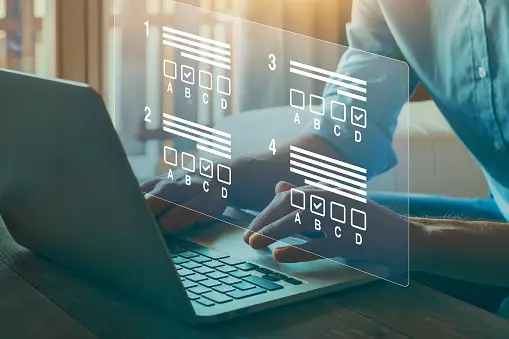

Vbuilder is a revolutionary API system designed to empower educators and content creators worldwide with the tools to craft an expansive array of assignments. Whether you’re teaching in a classroom, developing online courses, or creating content for a global audience, Vbuilder provides the flexibility to design assessments that cater to diverse learning needs and educational standards across different regions. Here’s an extensive list of assignment types that can be created using Vbuilder
A staple in educational assessments, MCQs can be tailored to suit various levels of difficulty and can include images, graphs, or audio clips to enhance the learning experience.
Simple yet effective, these assignments quickly assess basic comprehension and factual recall, adaptable to any subject matter.
These allow students to provide brief, focused responses, encouraging clarity of thought and expression.
Ideal for language learning or reinforcing key concepts, students complete sentences or equations by inserting the correct term or value.
This type involves matching related items, such as words with definitions, questions with answers, or countries with their capitals.
Encourage critical thinking and in-depth analysis by allowing students to explore topics through structured essays.
Interactive assignments where students drag items to correct locations or categories, useful for sorting, sequencing, or diagram labeling.
Engage students with crosswords or other word puzzles, enhancing vocabulary and problem-solving skills.
Provide immersive learning experiences where students can engage with simulations that replicate real-world scenarios.
Students submit their work for peer review, allowing for collaborative learning and critical feedback.
Present students with real-world scenarios that require analysis, problem-solving, and decision-making skills.
Long-term assignments that involve research, planning, and execution of a project, fostering practical skills and teamwork.
Set up structured debates where students must research and argue their positions on controversial topics
Students compile a portfolio of their work over time, demonstrating progress and mastery of skills.
Create dynamic quizzes with instant feedback, allowing for self-paced learning and immediate reinforcement of concepts.
Students watch a video and respond to questions or prompts, enhancing visual and auditory learning.
Collaborative tasks where students work together to complete a project or solve a problem, promoting teamwork and communication skills.
Students assume roles in a simulated environment, helping them understand different perspectives or practice language skills.
For programming courses, create coding challenges that students must solve, with automated testing of their code.
Ideal for geography or history, students interact with maps to identify locations, trace routes, or mark historical events.
Students compile and annotate a list of sources on a particular topic, demonstrating their research skills.
Students create and submit presentations on assigned topics, allowing them to practice public speaking and organization.
Students explore and analyze cultural practices, traditions, or media from around the world, fostering global awareness.
For science courses, students document their experiments, observations, and conclusions, reinforcing the scientific method.
Students create timelines to map out historical events, processes, or development stages of a particular topic.
Language learners or students in media courses can submit audio recordings, practicing pronunciation or production skills.
Students respond to hypothetical scenarios, applying their knowledge to practical or ethical dilemmas.
Students analyze and interpret data sets, often using software tools, to draw conclusions or make predictions.
Students create mind maps to visually organize information, demonstrating their understanding of relationships between concepts.
For more advanced settings, students engage with VR environments to explore complex concepts or scenarios.
Students annotate texts with notes, questions, or comments, fostering deeper engagement with reading material.
Create assignments where students interact with diagrams, such as labeling parts of a cell or identifying components of a machine.
Encourage students to develop their narrative skills through short stories, poems, or scripts.
Students design and conduct surveys, then analyze the results to understand public opinion or gather data for projects.
Assign students to maintain a journal where they reflect on their learning process, challenges faced, and personal growth.
For language courses, students translate texts from one language to another, enhancing language proficiency.
Students explore virtual environments and submit reports or reflections on what they observed and learned.
Design educational games where students can learn through play, reinforcing concepts in a fun and engaging way.
Students conduct interviews with experts or community members, then analyze and present their findings.
Assignments where students record or present speeches, helping them build confidence and communication skills.

Vbuilder’s versatility ensures that educators and content creators can tailor their assignments to meet the needs of diverse learners, adapting to different educational systems, cultural contexts, and technological capabilities. This flexibility supports global education by allowing for the creation of assignments that resonate with students from all over the world, fostering a richer and more inclusive learning environment.

Location in Malaysia
23-5 Menara Bangkok Bank
Berjaya Central Park
Jalan Ampang
50450 Kuala Lumpur
Malaysia
davidcheng@aismartuallearning.com
Contact : +60 17-770 0887
Location in Uganda
Plot 31 Ntinda – Kisaasi Road, Ntinda Shopping Complex, Block C 3rd Floor, Kampala, Uganda
Contact : +256 771627172
© 2024 Vlearned.com All rights reserved